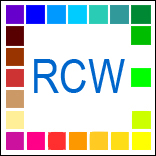Q Where can I find the list of the 50 colors you have included that will keep me from mixing 2 colors, which makes painting faster. Where is this listed in the RCW course? I could see only 36 colors.
A There are only 36 arcs or wedges of color. There are 53 color dots on the front and 58 pigments on the back. You can use them all or go to this page for shortcuts.
http://www.realcolorwheel.com/mypigments.htm Q How can I paint without mixing if I have to mix complement colors for the dark neutral or neutral gray ? Can I just use a darker pigment listed in the same block's darker side or the opposite block's darker side instead of mixing with the complement. For example to paint shadow on a red object , which is wedge #7 of a 36RCW, instead of mixing it with the opposite wedge color, can i just use 7.9 or 7.10 or can I even use 25.6 since those are already mixtures of opposite colors?
A You got it.
Q Is only yellow an exeption for this? Or yellow and orange and red, all these three are exeption to this ?
A Yellow is the main exception, orange only has one other color but it's important because it's transparent, Cad orange is opaque and must be darkened with the same dark brown as yellow. Red needs no correction, the opposite color cyan will make all the darker reds including the darkest brown.
Q RCW#33.6 is a 3 pigment together combination, PG 36 + PY 3 + PO 49 . Do you consider this one color .
A One pre-mixed pigment, yes.
Q Or a mixture of three pigments and hence not pure according to some artists. You say that mixing two is allowable. Do you consider this as mixing three.
A No, mixing 3, say the three colors of a split complementary set could make what is called a "designers" color. That's where a lot of the same color is made at one time, for a room maybe. It's harder to duplicate a three color mixture. Matching two color mixes is easy. I can match natures colors quickly with 12 colors, but I have to have them all.
Thank you for helping me with my questions.
I have more after this. Thank you again for being willing to help.
May God bless you.
Rency.
On Sun, Mar 20, 2011 at 12:18 AM, Don Jusko wrote:
On Mar 19, 2011, at 12:27 PM, ranchS wrote:
Q I read from some articles that when a paint or color has more than one pigment it is less pure ( less purer the more number of pigments mixed together). What is your opinion about this ?
A Mixing two pigments is common, most accomplished artists can view this made color and know the pigments used. Mixing three pigments is more rare, leave that to artists that have been using the same palette for years. You can usually get the colors you want with one or two pigments.
Q This is a question I asked and the answer from you. I have, for example a tube of Naples Yellow Hue by Liquitex Basics which says PW6, PY42 and PY83, and a tube of Burnt Sienna by Artist's Loft which says PY42+PR101+PBK7. So are you suggesting that I should not buy these kind of colors or paints but get the ones that says only two or less pigment numbers ?
A No. The tube colors on the RCW are considered one tube colors. Naples yellow was once a one element color, antimony lead yellow, today that same hue is made from three elements and it lost it's texture and opacity. So if you want the hue either find some original and like it for its qualities that other past artists thought were very important or take the substitute which doesn't behave like the original. I have the original and won't settle for the lessor. Indian yellow br/side and flake white will make the correct Naples yellow color, that's 2 pigments or 2 tubes of paint. Mixing two is allowable. The 50 colors I have included will keep you from mixing 2 colors which makes painting faster. A lot of these colors are composite colors pre-mixed to give the colors I chose. Buying from the chart is important for brand names and correct hues. The pigment Names and Numbers are important if you want the correct color from any Brand.
As an instance, you can buy any brand called Magenta as long as the Pigment number is PR122. In fact they can call it anything they please, as long as the Pigment number is PR122. They can't mess with the pigment number.
Thank you for all the answers that you are giving me.
Rency.
Don Jusko
http://www.realcolorwheel.com/end.htm

 Home
Home

 Help
Help

 Search
Search

 Login
Login

 Register
Register

 Broadcast Message to Admin(s)
Broadcast Message to Admin(s)

 « Home
« Home  ‹ Board
‹ Board  Top of this page
Top of this page 
 Pages: 1
Pages: 1

